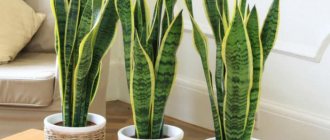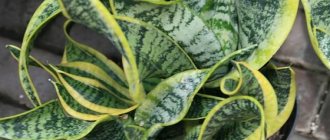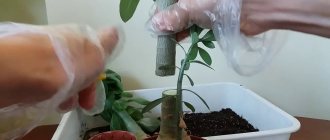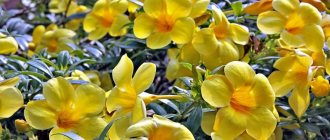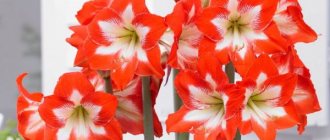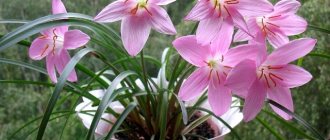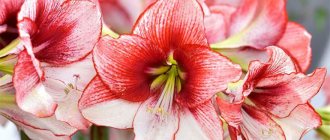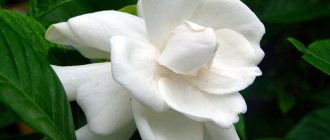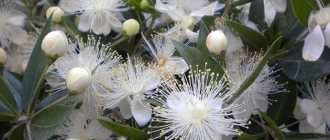Sansevieria has quite a few names, the most popular type looks like flames rushing upward, only green. The plant is grown with equal success at home and outdoors; there are certain rules for propagation, planting and care.
Mother-in-law's tongue flower - description
Sansevieria, according to various sources, belongs to the Agave or Asparagus family. The genus Sansevieria contains about 60 species. In nature, representatives of the genus can be found in the subtropics and tropics of Africa, Asia, America and Madagascar.
Sansevieria is a herbaceous plant with long, erect leaves. In most species, leaves grow directly from the rhizome, some have a small shortened stem. The leaves reach a height of 60-150 cm. They are collected in small rosettes of 3-13 pieces. The shape of the leaves is xiphoid, pointed. The surface of the plate is painted in different shades of green and decorated with zigzag horizontal stripes of a darker color. The edges of the leaves in some species are decorated with a light or yellow frame.
How pike tail blooms
With sufficiently bright lighting, Sansevieria may have a flower arrow appear from the center of the leaf rosette. The flowers are collected in paniculate inflorescences; the buds themselves are small, white and fragrant. During the flowering period of Sansevieria, the rooms of the house are enveloped in the delicate aroma of vanilla. After flowering ends, the leaf rosette from which the flower branch appeared dies off completely.
basic information
Much has changed since the unprecedented popularity of this flower; a huge number of more spectacular and exotic “pets” have appeared, displacing Sansevieria on its pedestal. However, breeders did not leave “mother-in-law’s tongue” without attention and, based on it, developed many decorative, hybrid forms that attract interested glances.
This evergreen stemless plant belongs to the Asparagus family and the flower genus consists of almost six dozen species. You can meet it in its natural environment in Asian and African deserts, semi-deserts and savannas. As a house plant, flower growers grow it in different parts of the world and everywhere Sansevieria is given another, poetic name, calling it “pike tail”, “leopard lily”, “cuckoo tail”, “Indian sword”, “snake skin” and even “African hemp" and "the tongue of the devil." In addition, there are several Latin variants, in addition to sansevieria these are sansevieria and sansevieria.
Sansevieria - benefits and harm for the home
Sansevieria is considered not only one of the simplest, but also useful plants. It can even be placed in a children's room or bedroom. The green parts of Sansevieria perfectly absorb harmful compounds from the atmosphere, saturate the air with oxygen, and destroy bacteria.
Mother-in-law's tongue is often used in folk medicine and is considered a real home healer. It is used to treat wounds, burns, headaches, otitis media, diseases of the gastrointestinal tract and normalize blood pressure. Despite its widespread use and many beneficial properties, Sansevieria should be used wisely and only for external use. Otherwise, plant-based preparations can cause poisoning, vomiting, severe allergic reactions and intestinal disorders.
The hard leaf plates of Sansevieria are not very attractive to children, and breaking them may not be so easy, but you should not allow children and family members to break, chew or tear off the leaves of the plant. The juice of this flower, when it comes into contact with mucous membranes, causes poisoning and vomiting.
Medicinal, beneficial properties of sansevieria, “mother-in-law’s tongue”, “pike tail”
Healing properties of sansevieria (“mother-in-law’s tongue”, “pike tail”). Treatment of colds, treatment of otitis media, treatment of gastrointestinal diseases.
Sansevieria is native to Africa and tropical Asia, where it grows in savannas, semi-deserts and even deserts. Sansevieria is an unpretentious stemless plant of the lily family; it has erect, sharp, lanceolate, dense, dark green basal leaves up to 1 m or more long, with transverse yellowish or light green stripes. The rhizome is creeping, powerful. Sansevieria blooms with fragrant, sticky nectar-producing pale green flowers, almost white, with narrow petals and long stamens. The flowers are located on a long peduncle-arrow.
Sansevieria contains a number of biologically active substances, but the most important of them for humans are saponins - highly toxic substances that, when used properly, can bring great benefits.
In traditional medicine, saponins are used in the production of laxatives, choleretic, expectorants, and anti-inflammatory drugs. In folk
In medicine, sansevieria is used for cystitis and adnexitis, otitis, and inflammation of the throat and oral cavity. It helps increase immunity, stress resistance, and improve the general condition of the body. You can use it for cuts and bleeding. For scratches and other shallow damage to the skin, it is recommended to apply a sansevieria leaf with the side from which the skin was previously removed to the affected area. The plant, like plantain, will disinfect and stop bleeding.
Saponins are glycosides of plant origin with surfactant and foaming properties. They are practiced in cosmetology in the manufacture of detergents such as shampoos, liquid soap, etc.
It is not recommended to use sansevieria in treatment during pregnancy, since it is believed that the substances contained in this plant have abortifacient properties.
Caring for Sansevieria at home
Caring for Sansevieria is very easy. This plant is incredibly hardy and almost does not suffer from harmful external influences.
Lighting
Sansevieria grows well both in a dark corner and on a light windowsill. As a rule, good lighting is the key to flowering of this plant. In a dark corner, variegated species can take on a monochromatic, simple color, so it is better to place them closer to the light source. Sansevieria should be protected from the scorching sun, otherwise brown burns will begin to appear on it.
Temperature and humidity
At home, potted Sansevieria can survive in a fairly wide range of temperatures and does not need special conditions. In summer, a normal temperature of about +18-+250C is suitable for keeping, and in winter it is better to put the pot in a cool, bright place and keep it at a temperature of about +14-+160C.
It is not recommended to allow the temperature to drop to +100C or lower, otherwise Sansevieria may freeze. In general, “Mother-in-Law’s Tongue” tolerates drafts and sudden changes in temperature well, but prolonged negative effects can lead to very disastrous consequences.
Most Sansevieria species come from dry regions, so they grow much better in low humidity. It is recommended to periodically wipe Sansevieria from dust with a damp cloth or napkin. In particularly hot weather, you can also spray it with warm water from the shower or spray it with a spray bottle. After the procedure, be sure to blot the sockets with a dry cloth and remove any moisture that has accumulated in them.
Watering
Water for irrigation is stored 1-2 days in advance so that it has time to sit at room temperature and become softer. When watering, do not allow moisture to get into the center of the outlet.
In summer
In the warm season, watering should be moderate. The soil in the hill is moistened in small portions about once a week.
in winter
From autumn to the end of winter, the soil in the pot is moistened approximately 1-2 times a month. The substrate should not be allowed to dry out completely between waterings, so if Sansevieria has drooped, it is better to slightly moisten the earthen ball.
Fertilizer
Special fertilizers for cacti are used as an additional source of nutrition. The frequency of feeding is once a month, only the dosage is reduced by half. Fertilizers are applied to the soil along with watering from spring to September.
Landing
Sansevieria can be grown not only indoors, but also in open ground, since it is very resistant to low temperatures. The main thing that is required from the grower is good drainage, since this species does not like large amounts of moisture.
If you water the sansevieria or plant it in a humid environment, it will soon rot and die.
The ability to withstand drought well has made the plant popular in arid areas as the main decoration of the landscape.
Sansevieria prefers full sun, but will grow successfully in light to moderate shade . However, some species with colored colors may not develop them if not given enough sun, meaning the leaves will remain just green without any gold edging. Moreover, too little light will result in weak growth and small bushes.
Over time, if the grower has chosen the planting site correctly, the plant begins to fill everything around it. In this case, there are three ways to deal with the problem:
- you can dig up shoots every 2-3 years;
- it is necessary to plant sansevieria in containers, which are then placed in the ground, thus they remain out of sight, preventing growth;
- install barriers several tens of centimeters into the ground, which prevent root growth.
The time for planting in the soil is early spring . This flower has no special requirements regarding the quality and fertility of the soil, so it does not require much attention. A small depression is made in the ground into which the bush is placed so as to cover the root collar with soil. The first watering is carried out, then the soil around is moistened no more than once a week and lightly.
If precipitation falls regularly, then there is no need to water.
Most amateurs and professionals grow sansevieria as a houseplant. She adapts perfectly to indoor life. It is best to place the pot in a sunny place , but even a room with a small amount of light is suitable.
For planting, you can use cactus potting soil or add coarse sand to regular sand to provide the quality drainage these plants need.
Allow the soil to dry out a little between waterings. The ideal container for sansevieria is made of clay, because this material is porous, allowing the soil to dry out faster than in plastic.
Some types of plants grow quickly, so they will need to be divided annually. For planting, you should use a container that is shallow but wide . The bushes have a shallow root system, but it grows well. The soil at the bottom of a deeper container retains moisture longer, which leads to root rot.
Replanting is done in the spring, at the same time you can fertilize the plant using a balanced composition (10-10-10 or 8-8-8). The second time, fertilizing is applied closer to the end of the growing season, that is, in August. The plant should not be fertilized in winter.
Reproduction
At home, you can try growing Sansevieria from seeds, cuttings and leaves. Any part of this plant can successfully take root and become part of your home collection.
Leaf
Whole leaves or parts thereof, cut horizontally, are used as cuttings. In order for part of the leaf to take root successfully, it must be about 4-5 cm high; it is also necessary to immediately mark the top and bottom, otherwise a cutting planted upside down simply will not take root. Before planting, Sansevieria is dried for several hours, then rooted in wet sand. The cuttings are placed in the substrate at an angle of 450 and covered with a jar or plastic bag. As a rule, after 1-1.5 months the cuttings take root and grow, after which the seedlings can be transplanted into the substrate.
Cuttings
Daughter rosettes are used as cuttings, which can be separated during transplantation. They are cut off from the rhizome and planted in separate pots. Only developed shoots are planted, with their own growing point and roots. Before planting in a new pot, the cuttings are slightly dried and treated with charcoal.
Seeds
Sansevieria seeds germinate well and amicably, but they cannot be obtained at home. Sow seeds in wet sand or peat-sand mixture. The top of the dishes is covered with film, and the substrate is moistened as needed through a tray.
It may take several weeks or even months before the first shoots appear, so the owner may need a lot of patience. After the seeds hatch, they grow actively and after a month they are ready for picking.
Transplanting Sansevieria
Sansevieria does not require frequent transplants. This plant feels best in a cramped pot, so even young specimens are replanted once every 2 years, and adults even less often. When the roots of the plant begin to protrude from the drainage holes, this means that it is time to choose a new pot for Sansevieria.
Priming
The soil for planting should be light and breathable. You can purchase a special substrate for cacti in the store or mix 2 parts leaf soil, 1 part sand and 2 parts turf soil. It is advisable to mix a little brick chips, pieces of coal, coarse sand or perlite into the prepared soil.
Pot
It is desirable that the planting container be wide and stable, with a sufficient number of drainage holes, 1-2 cm larger than the previous pot. You can choose a pot from any material, but it must be strong, since the roots of the plant can easily deform or break dishes with thin soft walls. The ideal choice would be a pot made of clay, ceramics or even a wooden planter for very large Sansevierias.
Watering
Sansevieria does not like spraying, does not tolerate well when water gets inside the outlet, and this can even rot. But the plant survives drought well.
The “mother-in-law’s tongue” flower is watered lightly and only after the soil has dried out. For some time he feels great without water. As mentioned above, at low temperatures, water the plant less often, the same applies to sansevierias placed in the shade.
Wipe the plant from dust from time to time. Use a cloth or a special broom.
Diseases
It is not for nothing that Sansevieria is called one of the most tenacious plants. She is very resistant to negative influences and very rarely gets sick. If the rules of care are violated, some difficulties may arise. It is important to recognize them in time.
Problems with leaves
Mother-in-law's tongue can react to strong changes, and its leaves often suffer. The following signs indicate that the plant is not comfortable:
- Turn yellow - cramped pot, lack of light.
- Drying tips - excessive watering, poor lighting.
- Curl - most often the cause is poor watering.
- Sluggish - the earthen ball is dry and needs watering. Even if the plant does not recover after watering, and the base of the flower becomes soft, this may indicate a rot disease.
- Falling apart (falling) - long, brittle leaf plates that cannot maintain a vertical position and fall apart indicate insufficient lighting. Then Sansevieria grows disproportionately long and falls apart. You need to move the pot closer to the light source and then the new leaves will grow normal and strong. The bush can be temporarily tied with thin twine or soft rope.
- Brown spots have appeared due to cool conditions and excessive watering. You need to move the flower pot to a warmer place and reduce watering.
- If it develops poorly or does not grow at all, Sansevieria grows better in a cramped pot, so if after replanting the plant has stopped growing for several months, then there is no need to worry. Also, Sansevieria does not need to grow actively with regular, abundant watering. Therefore, if you slightly reduce the amount of moisture, new leaves will soon begin to appear from the rosettes.
Sometimes, with excessive watering, cool maintenance, or moisture getting inside the leaf rosette, rot may appear. Therefore, you need to water Sansevieria carefully, trying not to get water on the leaves and rosettes. To save Sansevieria, it is taken out of the ground, washed, damaged parts are removed, then dried and treated with charcoal. Afterwards, you can plant the plant in a new substrate.
Growing problems
There are no big difficulties when growing sansevieria; it is a very flexible plant. But sometimes some problems may arise.
Dark spots on the leaves are due to waterlogging at low temperatures.
The leaves are turning yellow. The plant does not have enough light. Perhaps the pot is too tight.
The leaves are soft along their entire length and bend in half or deviate greatly from the vertical. Most likely, the sansevieria does not have enough light, so the leaves are very elongated and cannot support their own weight.
The leaves become soft at the base and begin to turn yellow. Perhaps water got into the center of the outlet and a fungal disease began.
The tips of the leaves wither, turn yellow and dry out. The plant is too cold, it may be overwatered or there is not enough light.
The leaves are withering. The plant has not been watered for a long time.
Pests
Sansevieria is very rarely attacked by pests. The leaves of the plant are too hard and covered with a thick waxy layer, so you can easily get rid of unwanted insects.
Red tick
Red mites are quite rare. It attacks growing points and hides in the axils of leaves. If pests are detected, it is necessary to treat with systemic acaricides, for example, Oberon.
Spider mite
You can get rid of spider mites using a soap solution; wipe all parts of the plant with it. In case of severe damage, you can treat the flower with Actellik.
Thrips
Thrips form colonies on the underside of the plates, while they lose their rich color and fade. To save the flower, you need to carry out several treatments with Actellik or Fitoverm.
Mealybug
If the plant is twisted or yellowed, this may be a sign of a mealybug. The parasite is removed in several stages: first, the plant is treated with a dry cloth, and then all its parts are sprayed with Karbofos.
Shchitovka
You can get rid of scale insects using a damp sponge. Parasites are removed manually, and then treated with Actellik, Karbofos or Fitoverm.
Sansevieria - popular species with names and photos
There are several varieties of Sansevieria that have found a home in modern homes and are popular with gardeners and collectors.
Three-lane or Trifasciata
The most recognizable species with sword-shaped leaves, dark green with transverse stripes and yellow edging.
Moonshine
An exotic plant with wide oval leaves growing directly from the ground. The leaves are smooth, about 30-35 cm high, collected in rosettes of 5-6 pieces. The leaves are dark green with a bluish bloom, giving the surface of the plates a light green dusty color.
Laurenti (Laurentii)
The leaves are grayish-green, erect, long and narrow. The bush grows up to 1 m in height. The surface of the leaf is decorated with stripes and a light frame along the edge.
Hanny
Sansevieria with short, almost horizontal, green, bluish or gray leaf blades. The surface of the plates is decorated with horizontal light or dark stripes.
Futura
A low-growing variety up to 30 cm high. The leaves are collected in dense rosettes of 12-13 pieces. The surface of the leaf is juicy green with a yellow edging.
Robusta
The leaf blades are wide, short, decorated with horizontal stripes of dark green color.
Golden flame
The leaves are yellow-green and elongated. They are bright yellow above and green below with a golden frame.
Twister Sister
Low-growing Sansevieria with curly leaves that are located almost horizontally to the soil. The plates are bright green with characteristic stripes and a light yellow wide stripe along the edge.
Whitney
Grows up to 50 cm in height. The leaf blades are wide, xiphoid, collected in rosettes of 4, have a wide dark green stripe in the center, and two-color stripes along the edges.
Black Gold
A variety with dense rosettes and light green leaves. The surface of the plate is decorated with horizontal dark stripes and yellow edging. The leaves are long, narrow, and have a bluish tint.
Black Coral
Grows up to 1 m in height. The foliage is lanceolate, dark green with transverse light, dark and grayish stripes.
Cylindrical or Cylindrical (Cylindrica)
This Sansevieria is perhaps the most unusual of all the others. Its leaf blades are not flat, but twisted into straight cylinders that can grow up to 1.5 m in height. The color is dark green with transverse stripes. An interesting feature of this species is its flexibility, the ability to take any shape.
Bonselensis
The leaves are voluminous, cylindrical, folded into a double-row rosette and arranged like a fan. The color is gray-green, with transverse dark green stripes.
Bacularis
The leaf blades are cylindrical, twisted into a tube, bright green with dark green stripes.
Zeylanica
Grows up to 1.5 m in height. The leaf blades are dark green with many yellowish, light green and white stripes.
Mikado
Sansevieria with thick cylindrical plates and dark transverse stripes.
Masoniana
It grows quickly and reaches 1 m in height. The leaves grow singly and curl into spirals and are bright green with a mottled pattern.
Samurai
The leaf blades are short, fleshy, grayish-green in color, fanned into rosettes opposite each other. There is a groove running through the center.
Pick
The leaf rosette consists of several erect green plates. The surface of which is decorated with light specks in the form of a brown-red stripe.
Star Canary
Wide and short leaves are folded into beautiful open spiral rosettes. The leaf blades are beautifully curved and painted a soft yellow with a bright green tip.
Metallica
A rare collectible variety with long silvery foliage. The surface of the plates is decorated with vertical creamy-white stripes. Grows up to 60 cm in height.
Grandis or Big
A species with wide and long leaf blades up to 1.5 m high. The leaves are green with dark zigzag stripes. A reddish border runs along the edges of the plates.
Black Dragon
A low-growing variety with a dense spiral-shaped rosette and wide, pointed leaf blades. The leaves are shiny, smooth, from dark green to almost black.
Varieties
In total, there are about 200 varieties of the “mother-in-law’s tongue” flower. The most common species is Sansevieria three-lane with flat oval leaves. They have a characteristic pattern - a light green stripe on a dark green background.
In the flower shop you can find other varieties of sansevieria, for example, Sansevieria trifasciata Laurentii with green and yellow stripes.
Or Sansevieria Zeylanica, whose leaves are variegated dark green.
If you prefer plants with short leaves, consider Sansevieria trifasciata Laurentii Compacta.
Fans of exotic colors will appreciate Sansevieria trifasciata Hahnii with silver stripes.
In cases where a very tall plant is required, you can purchase the species Sansevieria robusta, whose length reaches 180 cm. Its leaves are green, pointed, growing straight upward.
Mother-in-law's tongue flower: signs and superstitions
It is believed that Sansevieria is capable of absorbing negative energy and extinguishing conflicts in the family. As a result, peace, tranquility and understanding come to the house.
Mother-in-law's language has a special influence on students. It helps to solve even complex problems and overcome learning difficulties.
At home, such a flower is a powerful protector against the evil eye, damage and other bad influences. It takes away illnesses, improves mood, helps fight laziness and apathy.
Photos in the interior
In the house, Sansevieria becomes not only a decoration, but also a useful green pet that will create a pleasant, cozy atmosphere.

